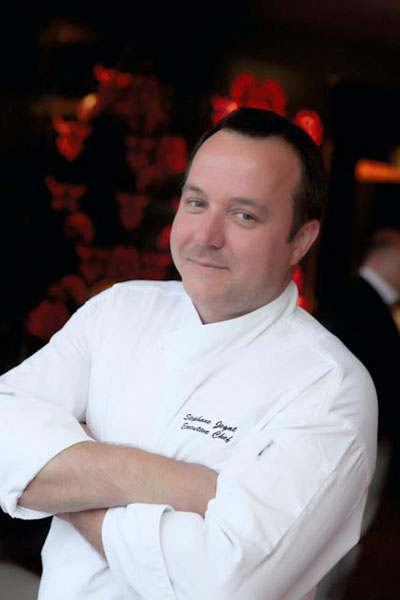
Chef Stéphane Jegat
It’s not every day I have the opportunity to interview a Chef Pâtissier with a history dating back to 1790.
I first met Chef Stéphane Jegat at the Monbana Chocolate masterclass at Kobe Jones restaurant. Over a couple of glasses of wine and bilingual conversations, I learned that his pâtissier ancestry was traced to the time of the French Revolution.
Stéphane began his culinary career as an apprentice in Grenoble in the south of France. After excelling in the Meilleur Apprentice de France, he moved to Paris to work at Fauchon under Pierre Hermé before relocating to England where he worked at the 2 Michelin starred, Le Manoir aux Quat’Saisons. His career later took him to Japan, the Phillipines and Kuwait before making Australia his home.
In this open interview, he takes me on a journey around the world and back in time complete with historical photographs.
~ ~ ~
Corinne: Tell me a little about yourself, where you were born and where you grew up.
Stéphane Jegat: I’m born just outside of Grenoble near the Alps on Halloween in 1967. It’s a place with a lot of chocolatiers. Many people go through it on their way to ski resorts. My father was born on the border of Normandy and Brittany in 1939 a few months before the war. He was an engineer. My mother was born in Algeria and had a secretary type job. I’m a middle child. My brother is 2 years older and my sister is 5 years younger.
C: And you come from a long line of pâtissiers.
S: It’s true that we have it in the family, enfin, my grandfather on my father’s side was pâtissier. In 1939, he was called to war and was a cook for the French army. He was prisoner by the German but he escaped before being sent to Germany and went back to his family in Sourdeval where he had a patisserie.
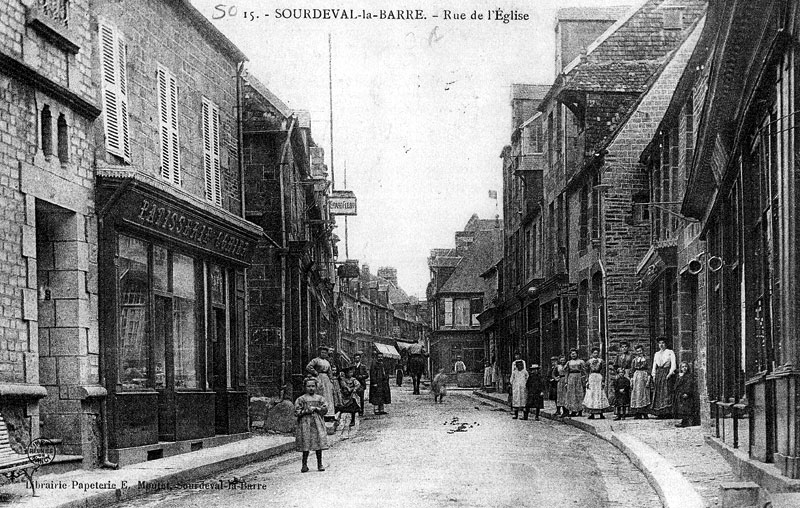
Grandfather’s patisserie in Sourdeval
My grandmother did some research and found than one of the ancestors went to war just after the French revolution, met his best friend at battle of Valmy in 1790 and when he came back home, he married the friend’s sister and he was a baker. My grandfather, uncle, godfather and cousin are cooks. Other family members had pastry shops in Brittany.
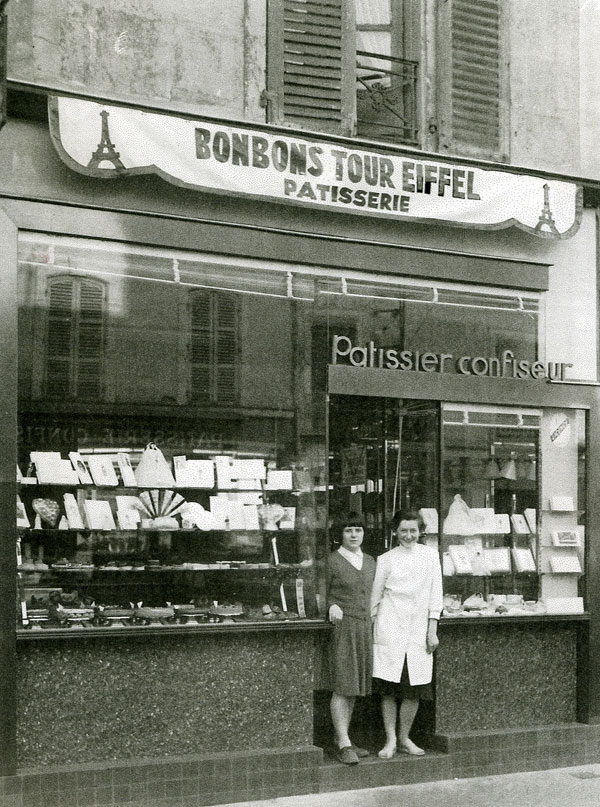
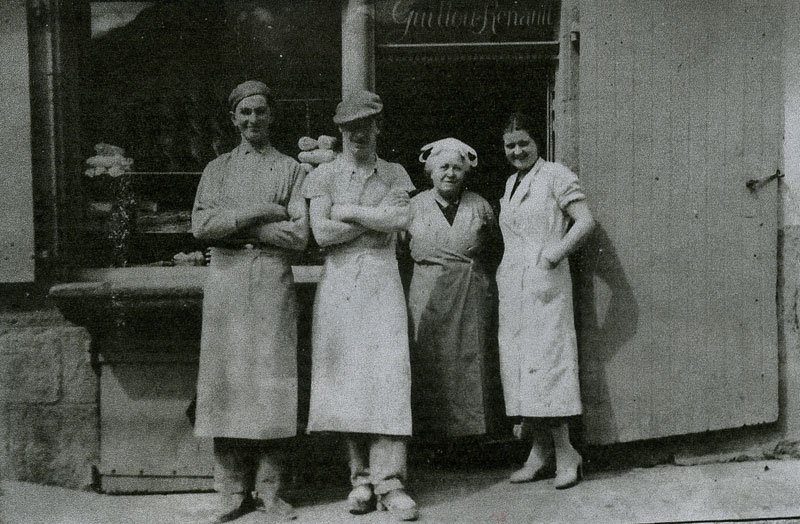
( L) – Grandfather’s second shop in Le Mans after the war; (R) – La boulangerie de la mère Guillou, on grandmother’s side, Quimperlé in Brittany
C: But your father wasn’t interested in pastry?
S: Non. At the time, they didn’t have so many products already made like now so the children of the pâtissiers had to help during their holidays and weekends. They had to pit the cherries, separate eggs, etcetera, and my father never had the envie to do it. His older brother, my godfather, Francis, always wanted to be a pastry chef. He worked with my grandfather then had a pastry shop in Granville. His sister married a pâtissier also. My father went to the navy academie for 7 years to get away as far as possible.
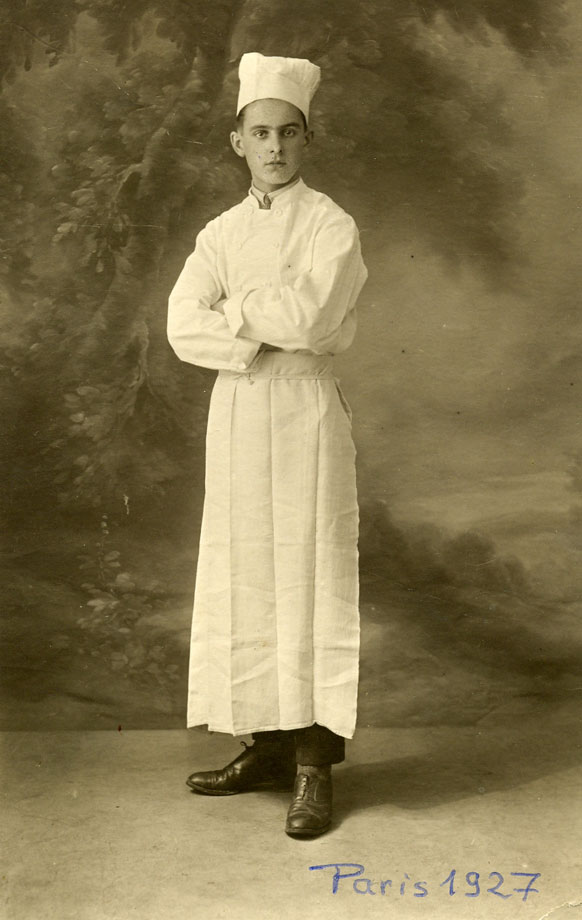
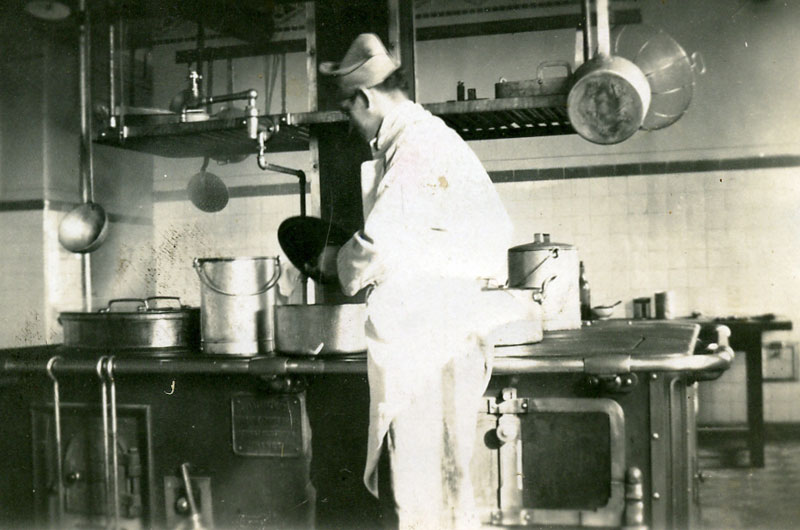
L – Grandfather Francis Jegat in Paris, pastry team at Felix Potin – R – Francis Jegat, army cook
C: Growing up, was there any pressure on you to follow in the footsteps?
S: Non. It’s not the type of job you force on someone. If you don’t really have the passion for it at the start, the little fire to go on every day, it’s hard to continue.
C: Was there a defining moment when you realised you wanted to be pâtissier?
S: Ah yes! July 1974, I was 7 years old. My parents rented a small house in Flayosc. I don’t know how but I was always awake early in the morning. I was bored to tears. They would leave me a coin to go and buy bread. I always remember this shop with a trap door. I was very interested in what was happening downstairs. After a few days of checking, the woman called her husband and said, “He’s here again”. He said to me, “Do you want to have a look or help?” And I went down the wooden steps and saw the big oven. I came back and stayed every day. My first job was to put the pastries in the paper cups.
My parents didn’t know where I was. There was no bread. There was no me. Then my father checked the baker and ah, he’s downstairs and that’s when it started. I told my father I wanted to be a pastry chef, and he stuck by me.

1st year apprentice (L) at La Noix de Grenoble – 1982
S: It was at La Noix de Grenoble, with Jean-Noël Desany in avenue Alsace-Lorraine in Grenoble. My father went there, spoke to the owner and said he was looking for a place for an apprenticeship for his son and he took me for a one year pre-apprenticeship then 2 year apprenticeship. I did a certificat d’aptitude professionnelle (C.A.P.) a certificate for chocolat, glacerie, confiserie and patisserie.
C: Do you have a story that stands out in your memory?
S: My first day. It’s all about the uniforme. I wanted to be pâtissier but I wanted to dress like a pâtissier. My mum was very busy and didn’t have time to buy me an apron or make one so she insisted I take hers. So I went down la cave to get changed, came up, I opened the door and everyone burst themselves laughing. I was so embarrassed! The boss said, “Quiet! Back to work!” Even he had a smile, probably. It was a plastic apron… with a large union jack on it!
C: What was the first task you had to do at La Noix de Grenoble?
S: La plonge, it means to clean everything, then scrub the black trays used for baking. For my first job in pastry, he gave me 2 litres cream, a whisk, a large bowl and said, “Make me crème chantilly. It took me a hell of a long time. Everything he taught me, he taught me to do by hand.
C: Is that where you qualified for the Meilleur Apprentice de France? (Best Apprentice in France)
S: To be in the Meilleur Apprentice de France, you need to finish in the top of the département. I qualified because I finished in top 3 or 4. My boss said if I participated, he would send me to Paris to work for Fauchon. I never had the mentality for competition but at 17, I knew I was going move to Paris one year later and work there.
C: What was it like for a young pâtissier to move to Paris?
S: My father found me a foyer pour jeunes, a place to live in the 13eme arrondissement near Chinatown. I had never seen so many people in one place. I was lost in the métro 2 days in a row. I was late to Fauchon 2 days in a row. They thought I was doing it in purpose. It was like living in the bush and coming to the city.
In December 1985, we had a big fire in Fauchon on the day of the biggest transportation strike in Paris. And there were attentats in the streets. I thought Grenoble was a bit more quiet than here, should I leave… but I decided to stay in Paris.
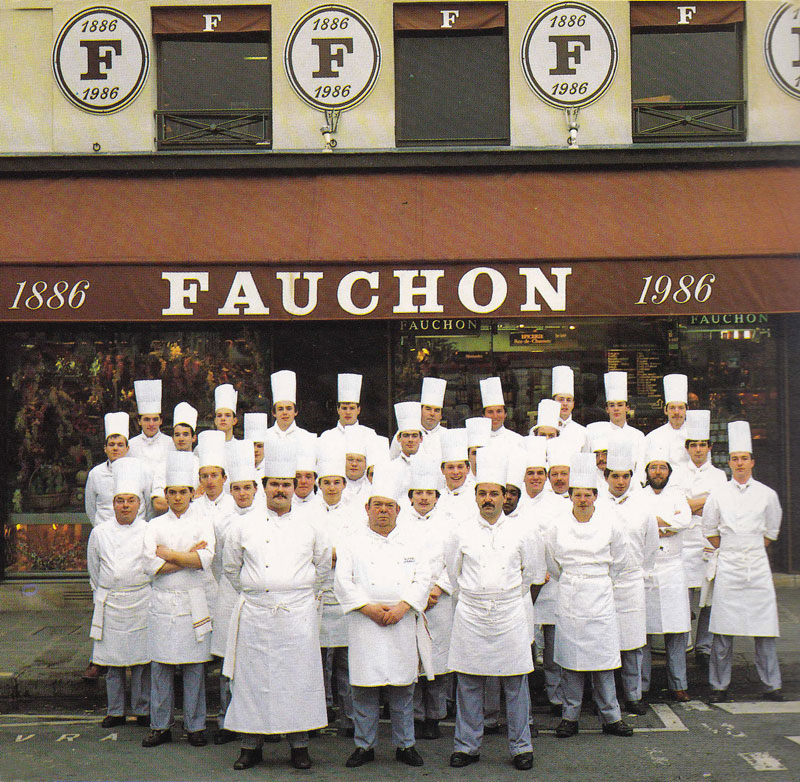
Fauchon Centennaire – 100 Years (2nd row, 5th from left)
C: Was it a major change for you working at Fauchon?
S: It was a big change for me. We were 3 people working in the patisserie in Grenoble. When I arrived in Fauchon, it was over 30 pastry chefs! Everything had its own spot, the tartes, petits fours, entremets, etcetera and many people I never met. They call everyone Monsieur. When you arrive, even if you’re late you have to shake hands with everybody. It’s very formal.
You work in one area, petits fours, tartes, le tour, macarons, entremets, enfin, not everybody can work in the same post because quality of product has to be the same, but you change every 6 months.
C: Did you have a mentor there?
S: I was trained by Monsieur Jean. I was making le tour, which is working with dough – always happy to have my hand in the flour, that’s me. [laugh] You had 2 people who bake for you. At Fauchon, you make the stuff but you don’t bake it. Somebody else does that. And you need to be nice to them or… if you upset them, they burn everything for you! It’s very well organised.
What was it like working under Pierre Hermé?
S: Hermé came from Lenôtre and he was 26 years old they offered him the position of chef pâtissier. He had completely different ideas. The first few months, we did what we used to do, then he started making changes. People who were there for a long time weren’t happy. He had a harsh time at the beginning and found himself a little alone. Also I was hired by the chef before.
He brought many changes and it was difficult to adapt to it quickly. I’m a strong character and he’s a strong personality also. I was officially a pain in the neck. I have not changed much. [laughs] I mellowed a little bit…
You stayed at Fauchon for four years?
S: From November 1985 until 1989 and did my national service in between. When I came back, I found many chefs had left. One day, they called me to help with the entrements and that was the cherry on the cake.
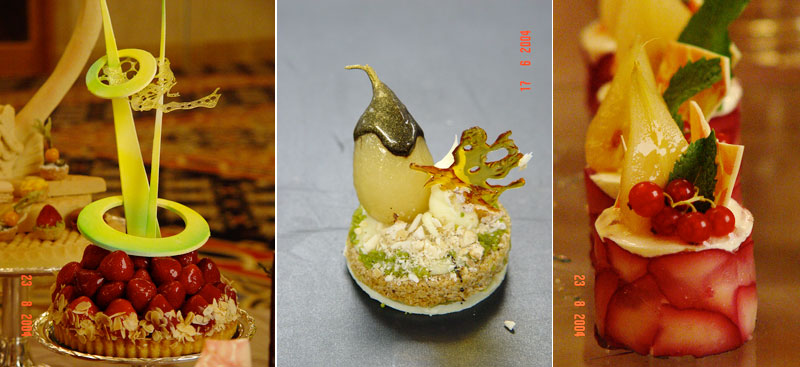
Strawberry Pie – Crystal Pear – Rubis Mini (Kuwait)
C: After Paris, you made the move to England. Was that always your plan?
S: My father always wanted to send me to England. [raises hands in the air] Not interested! Rare roast beef! I was afraid to go there because maybe I could not eat!
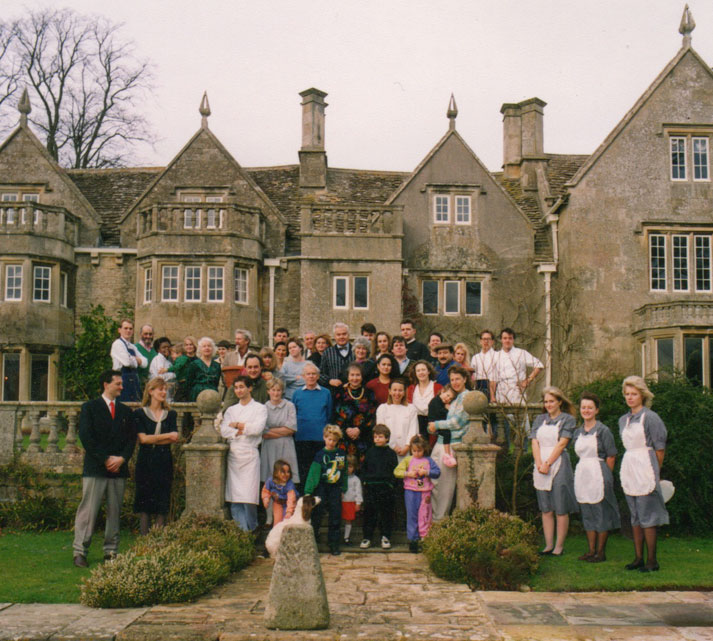
Woolley Grange
First restaurant was Woolley Grange, a small manor near Bradford on Avon and Bath. When the Gulf War started, business went dramatically down, I needed to find another job. I met Laurent du Chêne MOF who has now a pastry shop in Paris and who was, for years, executive pastry chef at Le Manoir. He told me Raymond Blanc was looking for first commis. I went there and met Nicolas Jambert who was the pastry chef and told me I had to make a pastry on the spot. Nobody had told me before so I was unprepared. The dessert tasted good but it looked crap. And when I saw Raymond Blanc, I apologised and said, I understand why you don’t want to give me the job. He said, no, I apologise because we did not tell you beforehand. He offered me the job.
C: Apart from the language, what did you find that was different?
S: The volume of work was a major difference. Enfin, we had that at Fauchon but we were 30 pastry chefs. At Le Manoir, we were only 5. Also, working in a pastry shop, I hadn’t done any plating before and over there, it was a work of art.
I loved my time at Raymond Blanc and stayed for 18 months. Anybody could come in and visit the kitchen. I was 22-23 and worked with many chefs who are very famous now and I’m very pleased for them. I left because I wanted to be no 2 but it was offered to someone else. So I went to work for a company called Truffles catering for Maclaren F1 before moving to Japan.
C: In Japan you were Head Pastry chef of the Hilton Tokyo Bay where you stayed for 5 ½ years. Did you find it a culinary culture shock at the start?
S: I worked in Osaka first then Tokyo. Some of the products and supplies I never worked with before. Everything was written in Japanese, of course, sometimes it was difficult to order without seeing the product. I was a little bit alone in that. At the Hilton Tokyo Bay, it was a 24 hour operation with 9000 covers a day. We were 20 pastry chefs, 10 bakers with a total of 240 chefs in the kitchen.
C: Did it seem more relaxed when you moved to Manilla as Executive Pastry Chef for the Peninsula group?
S: When I went there, they told me it was a busy place. I said, define busy. They said, 3500 covers a day. I said, I did that for breakfast alone!
I started to flourish as a pastry chef in Manilla. What I learnt from the Philippines is that you are as good as your team. Because if you are very very arrogant, they won’t do anything for you. So what I learnt the most in the Philippines and later in Kuwait is how to work with people from different cultures and get them to perform to the level you want.
C: Why Kuwait?
S: I went there as Executive Pastry Chef to open a new convention centre. Part of my family was born in North Africa so I wanted to work in the middle-east. I had carte blanche there. I could do anything I wanted but I had to teach them everything. I wanted it to be the top notch place in Kuwait where others wanted to be like us. We had the perfect opening. If you’re not organised in pastry, you’re dead.
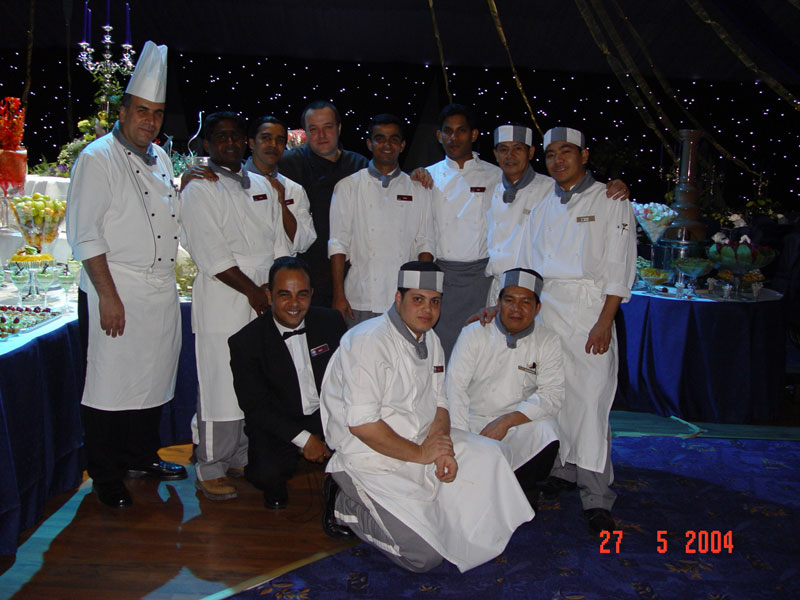
Pastry Team – Kuwait
C: Where did you work when you came to Sydney?
S: I worked at Nick’s Seafood Restaurants. I was in charge of pastry for most of their restaurants. Then I worked with Serge Dansereau at Bathers’ Pavilion, the Merivale Group. I helped open Kobe Jones at the Wharf and met my wife and wanted to stay in Australia.
You took a lot of ideas from the world. France, England, Japan, the Philippines, Kuwait and now Australia. From a chef’s perspective, what are the major differences with regards to food between these countries?
S: For that I have to go back. The food we have now and all the possibilities, we didn’t really have that in 1982 when I started.
I am a traditional classic pastry chef trained. I started in a shop, I moved to Paris, used different product. Did I learn about different flavours? Yes. Did I learn how to drink beer in England? Absolutely.
Different type of ingredients, different type of eating habits, different presentation of food. I was amazed by the minimalist style of the Japanese chefs and the finishing of the product was just completely different. Some of these chefs were better than me. They do it day in day out for 10 to 15 years.
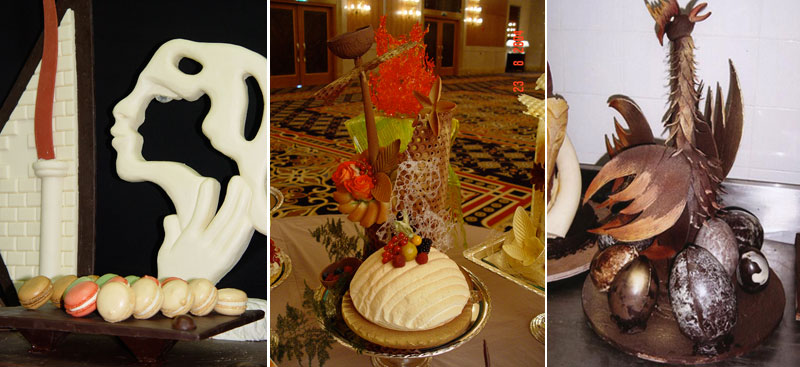
Abstract and macarons – Almond dome – Easter display in chocolate (Kuwait)
C: How would you describe yourself?
S: I’m supposedly an arsehole. I don’t know…My father only told this story me a few years ago. Back in 1987, he met Pierre Hermé who told him I was a very hard boy to work because I always had a strong character, etcetera etcetera. But my father never told me that until a year ago. So now when I reflect, I think I can be a very nice person. Some people say I can be a bit of a perfectionist.
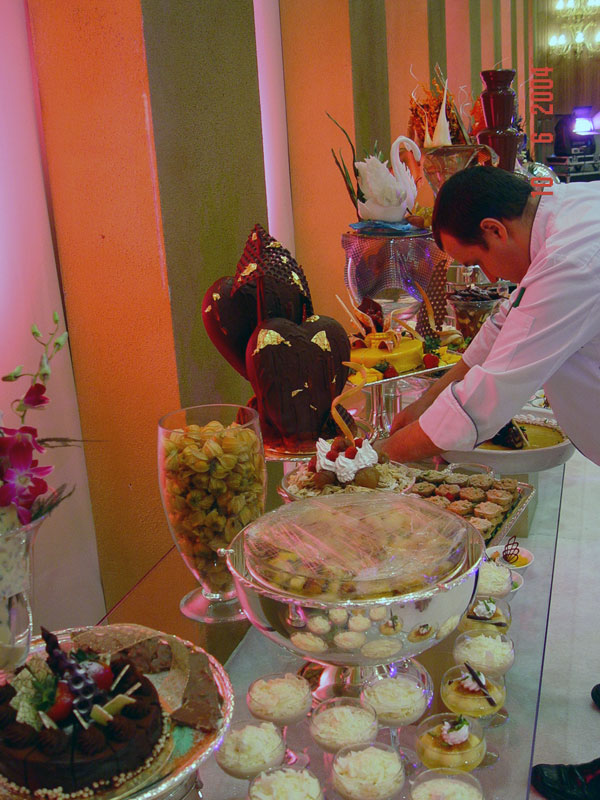
At Araya by Mariott – Kuwait
C: Do you think you’re a perfectionist, regardless of what people say?
S: Yes, it’s true. Not in everything. Sure my wife would agree. Sometimes I’m very direct and I have a bit of a loud and strong voice. [He leans forward] You’re Dr Phil, now… I’m not going to tell you everything but because I have a strong voice, the tone of my voice can be misinterpreted and become intimidating.
C: Who has been an influence or a source of inspiration to you?
S: My mother always impressed me about something because she always cooked very very well. She was never afraid that when my grandfather, grandmother and uncle used to come to our place in Grenoble, knowing that they’ve been in pastry, enfin, my grandfather was in pastry for 55 years! She always cooked well.
C: Apart from your family and heritage, are there any people who have marked you the most?
S: I would say the kindness of the people in the south of France in 1974. They were very kind in their own way to offer me the opportunity I will never be thankful enough for that.
Jean-Noël, of course, who I consider like a second father to me. At Fauchon, it was a lot harder but to have the chance to work with Pierre Hermé who is now probably the most famous pastry chef in the world. Raymond Blanc in England who offered me the job, he’s a lovely man. In Osaka, not really but in Tokyo, Patrice Gabet. He was tough, oh! But he always saw the good in me.
C: What do you do to relax?
S: I play golf. I spend my time with my family. I like to chill out in front of the TV…. I spend time with my son who is now 4 months old.
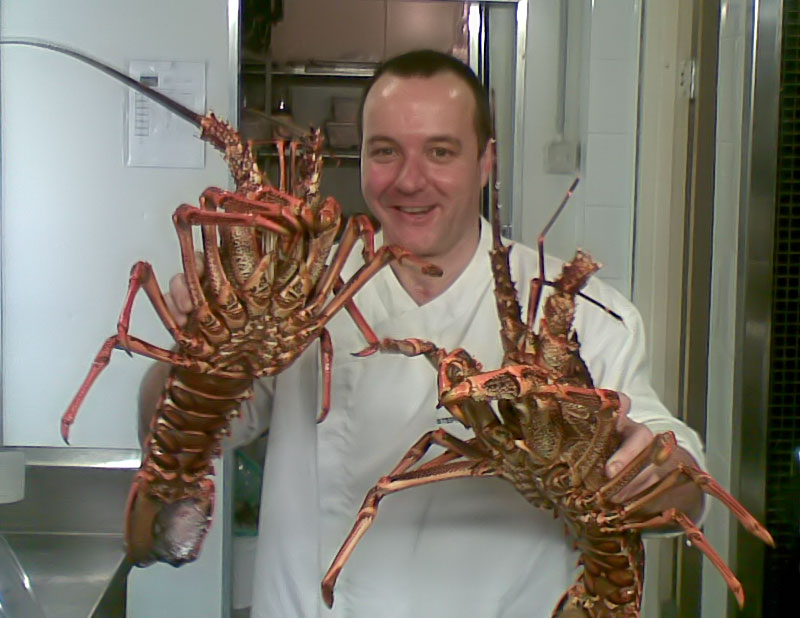 C: Do you cook much at home?
C: Do you cook much at home?
S: Sometimes. My wife Katherine cooks very well.
C: Tell me your favourite meal and what you like to cook and eat.
S: Gratin dauphinois! With Sebago potatoes, fantastique, and good cream. I do a bit of cooking sometimes, enfin, I do pastry. I do my own brioche, with a good French butter… it has to be salted, beurre échiré, a bit of jam…
Sometimes I cook with an Asian touch. I also do lobster salade. I love to have some saucissons and cornichons. I have a good friend who makes good saucissons. I enjoy my paté… if it’s just me, I just make pasta, or toastie ham and cheese.
C: Do you have a favourite pastry invention?
S: If you ask me about my best recipe, I say I did it with my wife. We have a beautiful boy and I’m very happy!
The Cherry Blossom is one of my favourite creations. My favourite cake of all is my mother’s gateau aux pommes, apple cake that I gorge myself with.
C: Describe the cherry blossom for me.
S: Ah… non non non. No secrets, huh? [laughs] OK… I tell you. It has a financier base which is very rich and moist, vanilla cream, thin line of crunchy chocolate in the middle, with grillottines cherries in red wine.

Cherry Blossom
C: France has long been considered the culinary centre of the world. What impresses you about French cuisine?
S: For that I would say, is it really the centre? Originally, yes. France has been very very good to export the knowledge of French cuisine. People can say you’re nationalistic and I am a true blue French, born French die French, but French cuisine forms a good basis for fine dining.
C: Do you think it has changed in recent years?
S: En fait, many people say the capital of food is now London. The French are very traditional in many ways. They open a restaurant and they’re very happy with what they cook and eat. Now you start to have much more Japanese restaurants, but the French take a very long time to change.
Les roast beefs, enfin, the anglo-saxons are a bit different because they never really had that culture. In England, friends told me, we eat because we have to. For them it wasn’t a pleasure. For them to become a pleasure, it took a hell of a lot of foreign chefs to go there and change the eating culture.
C: What is your opinion of the Sydney food scene at the moment?
S: You have so many restaurants that open, you have the effect of Masterchef in some ways, that means so many more people are interested about food. It’s become a little bit of a fashion. In some ways it is very good but what is important is consistency. What I find is that many chefs are moving restaurants too quickly too often. The food is about the chef, and the reward to the restaurant is attached to the chef. When the chef goes, and you follow the guide and go to the restaurant, it’s not the same.
C: How would you like to see it change?
S: Better to check the restaurant more than two years in a row then decide whether to give them a hat. If a restaurant just opened, and it gets a hat, maybe one year later, it won’t be there any more or the food will be completely different or the chef will move. Critique is an emotional and personal thing, from the chef to the writer.
Some restaurants are not interested in having a hat. Yes it’s good to have it but if you lose it, it can cause a lot of damage. I think restaurateurs should be asked if they want to be part of it. This would be a good thing to do. Even if you’ve been in the business for many years, you are as good as your last service. I think we shuffle a bit in Sydney.
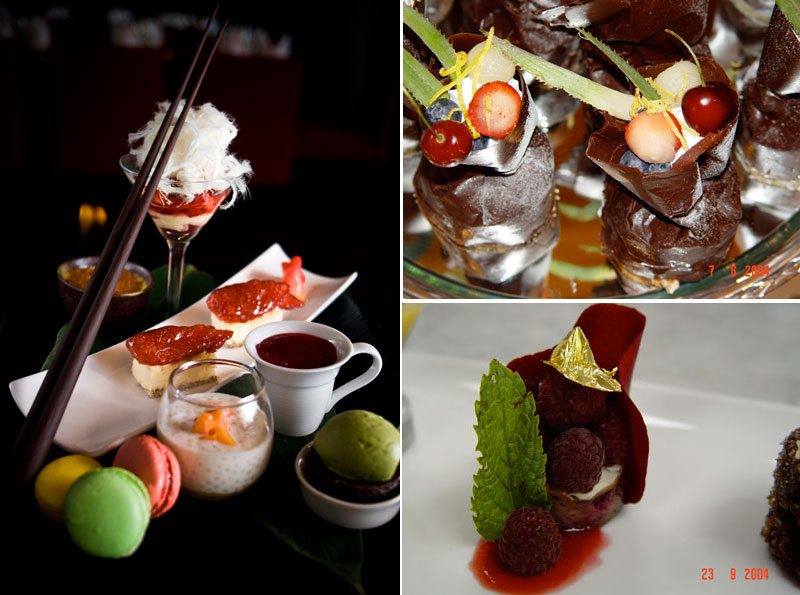
C: What do you think of the celebrity chef craze?
S: [laughs] Half of my friends are celebrities and I’m very happy for them!
It’s very good for the awareness of food, but now every body is an expert. It’s good for business. People are interested in cuisine, they buy more books and products. Many people want to open their own place. I think it’s good in some ways, but too many places are opening and closing too quickly.
C: Do you see it changing any time soon?
S: It’s the fashion now, la mode, as we say in French. You have Masterchef in America, in France, in the UK. It was very new. As a chef, do I really want to watch it? When my friends are there, yes. But it is a lot of hard work on top of being a chef and not many can be successful at it.
C: There’s been a lot of media interest of late about pastry chefs. What is your opinion of the new generation of pâtissiers?
S: A lot of young pastry chefs need a lot more training in general. They need to work in different places before opening a shop. What would be good is to see young chefs travel more and work, not just do a stage, for a few weeks but spend at least the next 3-4 years working in some good places around the world.
C: You’ve recently become a father to a baby boy. Do you have aspirations that he’ll follow in the family’s footsteps?
S: My wife refuses but that’s something to work on! [laughs] I’m sure he will be very interested and I try to have him my way. Enfin, he will taste my brioche, we have to make cookies and birthday cakes for his friends etcetera. I tell my wife, I want to have a little chef uniform so we can take a photo. I never had one myself so I want one for him.
I will work on my son from now to the futur, even if he doesn’t become a chef, so that there is a mystery and a heritage to know. He has a mother who cooks very well and a grandmother in France who is a Cordon Bleu. It has to be in the blood, non?
C: Any future plans or projects are you currently working on?
S: I would love to open a patisserie with my wife. I do feel like I need it. I also want to be able to share with more people my knowledge of pastry, to do what I am fond of, to use my creativity, to open that to… enfin, my customers. Maybe I’ll do it a bit differently because I had different training. My wife believes in me that I have a lot of potential and I need somebody good at the front, and I found the perfect person.
I also want to do a lot of teaching with those who are working with me, etcetera, there are so many things to learn and I don’t want people to lose this knowledge. A lot of trade is being lost, not just in pastry, because now you have big factories that do the work. We are losing skills, and it is time people like me say it would be nice to create an academie to preserve what to do.
If you were to sum up Stéphane in one dessert or pastry, which would it be?
S: Good question! Caramel moux, a soft caramel. Because I always look tough but I’m a softie. And I’m always made for pastry.
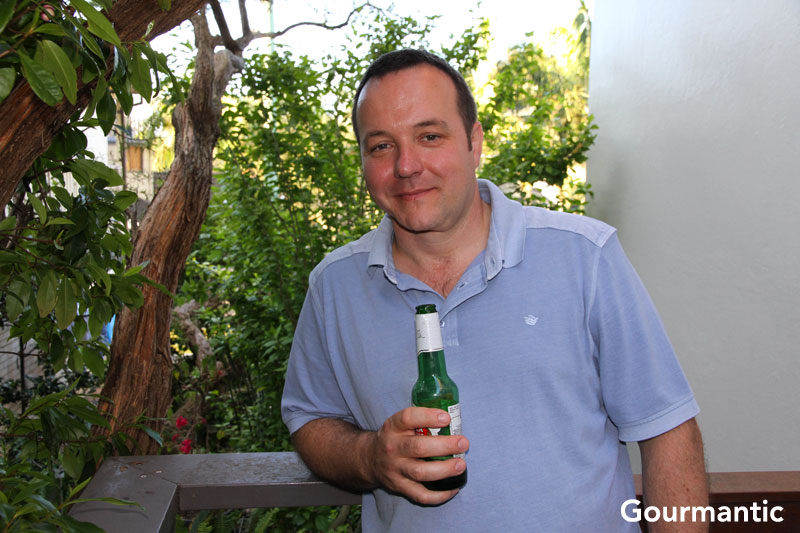
Stéphane Jegat
With many thanks to Stéphane for taking me on this historical and culinary journey.
Photo Credits: Stéphane Jegat – Used with permission.
Update 17/9/2013 – It is with great sadness that we learned of the passing of Stéphane Jegat on 13 September 2013. He will be missed around the world.

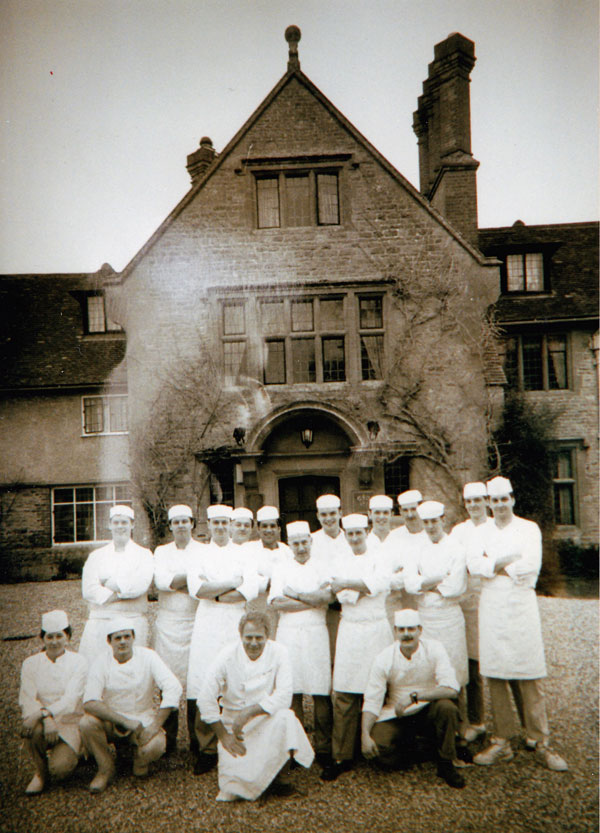


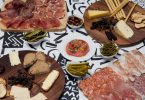


[…] am privileged to have Executive Chef Stéphane Jegat show me around. Born in Grenoble in France, Stephane comes from a long line of patissier chefs […]
Wow, this is a fantastic interview & post Corinne. You did a wonderful job on this & I especially love the history interwoven with the photos & anecdotes – what an interesting (& “sweet”) life!
Merci Tuula. I’m very privileged that Stéphane granted me his time for the interview. It’s been a few months in planning and I’m so pleased to share his talents with the world.
Nice! RT @Gourmantic: Love French patisseries? Our interview with Chef Stéphane Jegat will make you hungry! bit.ly/tEUyzJ #pastries
This comment was originally posted on twitter.
Fantastic post > Stéphane Jegat: Interview with the Man Behind the Chef Pâtissier gourmantic.com/2011/11/07/ste… via @Gourmantic
This comment was originally posted on twitter.
Oh yeah, you go Stéphane!
This comment was originally posted on Facebook.
Fantastic interview! Enjoyed reading every word of it – well done 🙂
This comment was originally posted on Facebook.
Nice article. Bravo Corrine.
So much experience in less than 45 years. Stephane clearly deserved that article.
I am looking forward to enjoying great meals at Kobe Jones…
Merci Eddy. So pleased to have shared Stéphane’s talents in this interview!
Stephane is a great friend and an excellent chef I have known from back in Japan many years ago when we we were much younger. It’s great to see how well he is doing and has grown as a chef. Great guy!! Robert sends Greetings from Texas too buddy.
Thanks so much for your comment BJ. Stéphane is reading the comments and I’m sure he’s very touched to hear from his friends around the world!
[…] Chef Stéphane Jegat […]